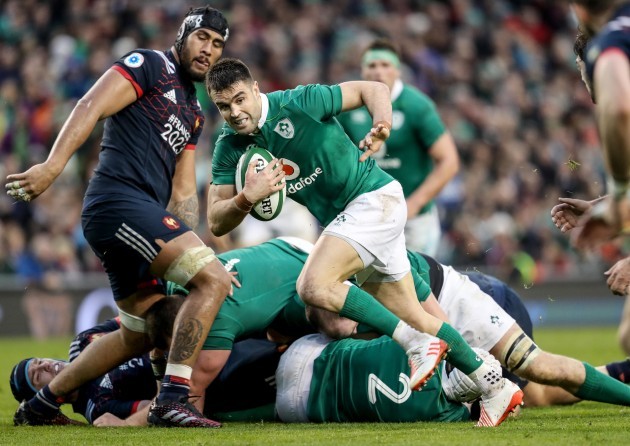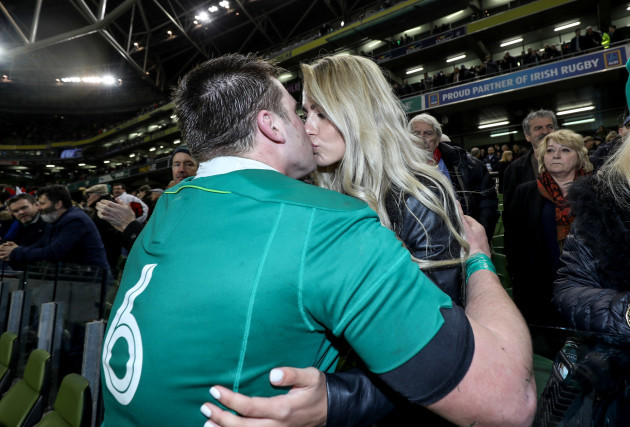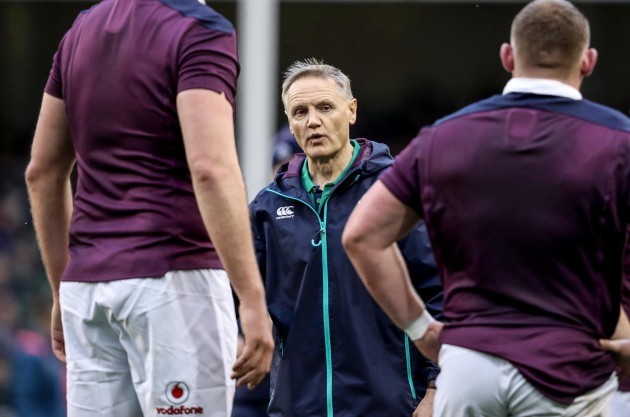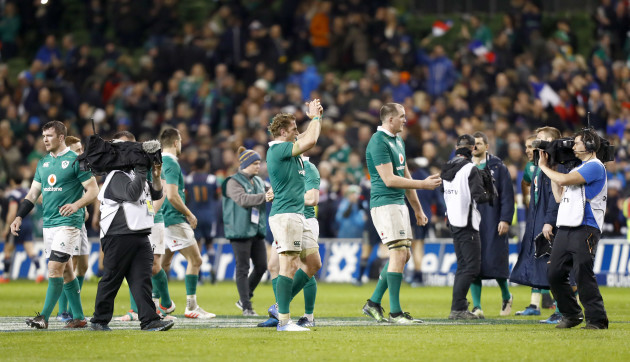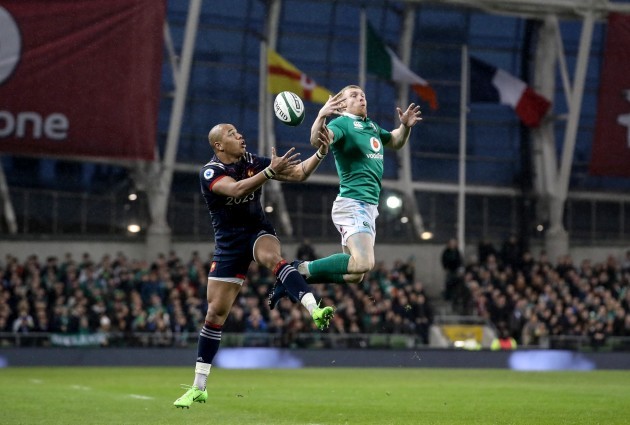Murray Kinsella reports from the Aviva Stadium
JOE SCHMIDT’S IRELAND made it two wins from three in the Six Nations with a 19-9 victory over France in tough conditions at the Aviva Stadium.
Read our full match report here.
Commanding halfbacks
In Conor Murray and Johnny Sexton, Ireland had the two most influential players on the pitch. While the scrum-half is well able to direct proceedings without Sexton alongside him, the Leinster man appears to bring out the very best of Murray.
With the experienced out-half communicating forcefully, managing Nigel Owens and steering Ireland’s attacking play, Murray thrived in the nine shirt. His sniping game was back to its very best – resulting in a try – while his kicking provided control and allowed Ireland to pressure the French.
Sexton, meanwhile, got a poor kick out of the way early on and then sparked most of Ireland’s best attacking spells, getting great success from the famous loop play, both when he accepted a return pass and simply provided a decoy around the ball carrier.
His passing – again, an early error aside – was crisp and the superb 40-metre drop goal was a highlight, one Sexton clearly enjoyed – his third for Ireland and his first since the 2011 World Cup.
On top of the these skills, Sexton and Murray bring huge defensive quality. The out-half was as willing as ever to put his body on the line, finishing high in the tackles completed chart. Murray was busy too, in what was a superb outing for Ireland’s halfbacks.
Room to improve
Ireland will have to take quiet satisfaction from this victory, as they ground their way to a 10-point winning margin with the rain teeming down in the second half.
There was, as ever, outstanding work rate from Schmidt’s men, with Jamie Heaslip often leading by example. Garry Ringrose stood out in a backline performance that threatened to ignite on several occasions, but never quite made the final thrust.
The pack had some good moments at maul time and carried well, but they would have been frustrated not to finish a long period of pressure before half time, when they went back to the corner searching for a try that never came.
Indeed, that told a tale of Ireland’s first-half performance. Though they scored the only try of the game through Murray, there were errors in handling and at the breakdown that stymied other promising passages and allowed the French to relieve pressure.
With close to 70% of the possession, Ireland would have hoped to create more clear try-scoring chances, even with the weather conditions deteriorating in the second 40.
Schmidt is likely to focus on refining those shortcomings over the next two weeks, with a Friday night visit to Cardiff on 10 March to come. The Welsh will be desperate for success after their disappointment away to Scotland today, so another hugely tough tie awaits.
Ireland will back themselves to be better against Rob Howley’s side.
Tactical tweaks
There are always signs of Schmidt’s tactical brain in Ireland’s performances and we saw some clever examples against les Bleus in Dublin. Much like the overall display, these tweaks looked great at first but weren’t quite capitalised upon.
Schmidt’s now well-known set-piece strike play involving a dummy loop and pass back inside to fullback Rob Kearney was evident on two occasions in the first half, but the strike part of the play came on third phase rather than second phase these times.
Meanwhile, Ireland’s ever-growing use of the short tip-on pass from forward to forward grew another leg against the French, as the second forward often added in an extra pass out the back to the waiting Sexton.
These tweaks allowed Ireland to stretch France in a way they wouldn’t quite have been expecting but when Schmidt’s men did drag the visitors’ defensive line out of shape, they often followed up with an error.
The inside passes from Sexton in phase play were often very effective, with CJ Stander and Simon Zebo making good gains there, but again the follow-up from Ireland wasn’t quite clinical enough.
Championship still on
As Ireland ignored possible shots at goal in the first half, and instead chased tries, one had to wonder if a bonus point was on their minds. ‘Win first, then score tries’ is often their mantra, but it appeared Ireland were very hungry for crucial five pointers.
This win lifts Ireland to the top of the Six Nations table overnight on 10 match points, but it would be a major surprise if England didn’t notch a bonus-point win against Italy tomorrow to move back in front on 13 points.
Were England to follow that up with a home victory against the impressive Scots, they would come to Dublin on 17 points [perhaps even 18?] ahead of the final-round clash with Ireland.
It might even be that England only need a losing bonus point on the final day of the championship to seal the title. Of course, we can’t know what will unfold in the fourth round and Vern Cotter’s Scots will be bringing a degree of confidence to Twickenham.
Ireland can only control what happens in Cardiff, and their title hopes are alive for now.
Wing play
A return of zero tries conceded will be a source of happiness for Ireland’s defence, and there were many moments of excellence in this department, aside from Murray and Sexton’s efforts.
Ireland would have been hugely disappointed with the string of missed tackles that led to the first French three points, but they improved. The Irish back row provided a big tackle count, but it was the men out on the edges of the Irish defence that perhaps had the most stressful job.
Two early cross-field kicks from France suggested they had pinpointed the wide channels as a means for breaking Ireland down, and they did send much of their 31% share of the possession to the edges.
Zebo had one superb read and hit in the second half, racing up out of the Irish line to shut the ball down, while Keith Earls mirrored that proactive play 20 minutes later, hammering up to deny the imposing Uini Atonio a chance to build up a head of steam or pass to Yoann Huget in space outside him.
Andy Farrell’s systems place onus on Ireland’s edge defenders to aggressively close down the attack in this manner, even when an overlap appears. Ireland’s wings stepped up to the mark to shut down opportunities more than once.
